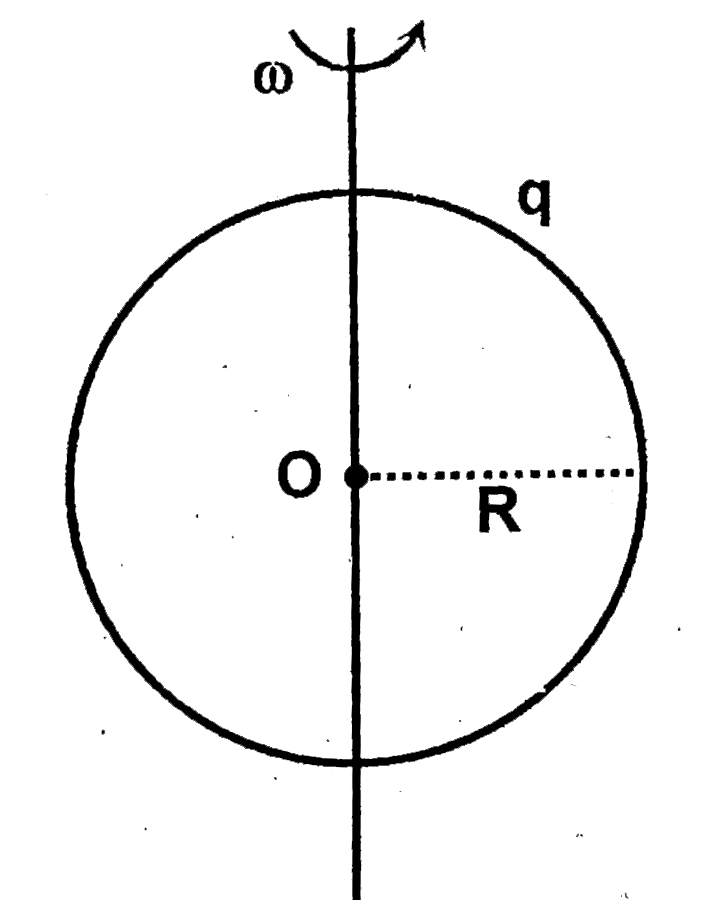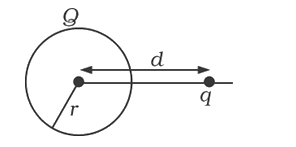An isolated conduction sphere sphere whose radius R=1 m has a charge q=19nC. The energy density at the surfasce of the sphere is
ε02J/m3
ε0J/m3
2ε0J/m3
ε0/3Jm3
The correct Answer is:A
To find the energy density at the surface of an isolated conducting sphere with a given charge, we can follow these steps:
Step 1: Identify the parameters
Given:
- Radius of the sphere, R=1m
- Charge on the sphere, q=19nC=19×10−9C
Step 2: Calculate the electric field at the surface of the sphere
The electric field E at the surface of a charged conducting sphere is given by the formula:
E=k⋅qR2
where k is Coulomb's constant, k=9×109N m2/C2.
Substituting the values:
E=9×109⋅19×10−9(1)2
E=9×1099×109=1N/C
Step 3: Calculate the energy density
The energy density u in an electric field is given by the formula:
u=12ϵ0E2
where ϵ0 (the permittivity of free space) is approximately 8.85×10−12C2/N m2.
Substituting E=1N/C:
u=12⋅8.85×10−12⋅(1)2
u=12⋅8.85×10−12=4.425×10−12J/m3
Final Answer
The energy density at the surface of the sphere is:
u=ϵ02J/m3
Given:
- Radius of the sphere, R=1m
- Charge on the sphere, q=19nC=19×10−9C
The electric field E at the surface of a charged conducting sphere is given by the formula:
E=k⋅qR2
where k is Coulomb's constant, k=9×109N m2/C2.
E=9×109⋅19×10−9(1)2
E=9×1099×109=1N/C
The energy density u in an electric field is given by the formula:
u=12ϵ0E2
where ϵ0 (the permittivity of free space) is approximately 8.85×10−12C2/N m2.
u=12⋅8.85×10−12⋅(1)2
u=12⋅8.85×10−12=4.425×10−12J/m3
The energy density at the surface of the sphere is:
u=ϵ02J/m3
Topper's Solved these Questions
- BOOK - DC PANDEY ENGLISHCHAPTER - ELECTROSTATICSEXERCISE - Exercise 24.14videos
ELECTROSTATICS
- BOOK - DC PANDEY ENGLISHCHAPTER - ELECTROSTATICSEXERCISE - Exercise 24.29videos
ELECTROSTATICS
- BOOK - DC PANDEY ENGLISHCHAPTER - ELECTROSTATICSEXERCISE - Example Type 83videos
ELECTROSTATICS
- BOOK - DC PANDEY ENGLISHCHAPTER - ELECTROSTATIC POTENTIAL AND CAPACITORSEXERCISE - (C) Chapter exercises50videos
ELECTROSTATIC POTENTIAL AND CAPACITORS
- BOOK - DC PANDEY ENGLISHCHAPTER - GRAVITATIONEXERCISE - All Questions135videos
GRAVITATION
Similar Questions
Knowledge Check
- Question 1 - Select One
A conducting sphere of radius 10 cm has unknown charge. If the electric field at a distance 20 cm from the centre of the sphere is 1.2×103NC−1 and points radially inwards. The net charge on the sphere is
A−4.5×10−9CB4.5×109CC−5.3×10−9CD5.3×109C
Two isolated metallic spheres of radii 2 cm and 4 cm are given equal charge, then the ratio of charge density on the surfaces of the spheres will be
View SolutionA conducting sphere of radius R is given a charge Q. The electric potential and the electric field at the centre of the sphere respectively are
View SolutionA conducting sphere of radius R is given a charge Q. The electric potential and the electric field at the centre of the sphere respectively are
View SolutionA hollow non conducting sphere of radius R has a positive charge q uniformly distributed on its surface. The sphere starts rotating with a constant angular velocity 'ω' about an axis passing through center of sphere, as shown in the figure. Then the net magnetic field at center of the sphere is
 View Solution
View SolutionThe electric potential on the surface of a sphere of radius R and charge 3×10−6 C is 500 V The intensity of electric field on the surface of the sphere ( inNC−1) is
View SolutionA solid conducting sphere of radius r is having a charge of Q and point charge q is a distance d from the centre of sphere as shown. The electric potential at the centre of the solid sphere is :
 View Solution
View SolutionA non-conducting solid sphere of radius R is uniformly charged. The magnitude of the electric filed due to the sphere at a distance r from its centre
View Solution

